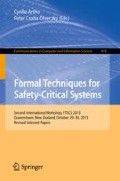Abstract
This paper introduces a method and a framework for verifying automotive system designs using model checking. The framework is based on UPPAAL, a timed model checker, and focuses on checking automotive system designs with FlexRay communication protocol, a de facto standard of automotive communication protocols. The framework is composed of FlexRay model and application model where the former is built by abstractions to the specifications of FlexRay protocol. In the framework, FlexRay model is reusable for different application models with appropriate parameter settings. To the best of our knowledge, the framework is the first attempt on model checking automotive system designs considering communication protocols. Checking of core properties including timing properties are conducted to evaluate the framework.
Access this chapter
Tax calculation will be finalised at checkout
Purchases are for personal use only
Notes
- 1.
Receiving buffers are not shown in the figure.
- 2.
Here we ignore symbol window (SW) and network idle time (NIT). The former is optional and the latter is for adjustment of cycle length. Both SW and NIT do not affect communications in automotive system designs.
- 3.
Generally, FlexRay only captures and throws errors. An application has the responsibility to handle errors thrown by FlexRay. Though not in the scope of this paper, if transmission errors are of interest, they can be modeled by adding error situations/states explicitly in FlexRay model.
- 4.
We used verifyta in command-line with -u option.
- 5.
For q2 and q3, all ten messages of indexes 1 to 10 are checked.
- 6.
Note that Receiver receives the data as soon as a receiving buffer is filled.
References
Altran Technologies: FlexRay Specifications Version 3.0.1 (2010)
Bel Mokadem, H., Berard, B., Gourcuff, V., De Smet, O., Roussel, J.-M.: Verification of a timed multitask system with UPPAAL. IEEE Trans. Autom. Sci. Eng. 7(4), 921–932 (2010)
Bengtsson, J., Larsen, K., Larsson, F., Pettersson, P., Yi, W.: UPPAAL - a tool suite for automatic verification of real-time systems. Hybrid Systems III. LNCS, vol. 1066, pp. 232–243. Springer, Heidelberg (1996)
Bøgholm, T., Kragh-Hansen, H., Olsen, P., Thomsen, B., Larsen, K.G.: Model-based schedulability analysis of safety critical hard real-time java programs. In: Proceedings of the 6th International Workshop on Java Technologies for Real-Time and Embedded Systems (JTRES’08), pp. 106–114 (2008)
David, A., Rasmussen, J.I., Larsen, K.G., Skou, A.: Model-based framework for schedulability analysis using Uppaal 4.1. Model-Based Design for Embedded Systems. Computational Analysis, Synthesis, and Design of Dynamic Systems, pp. 93–119. CRC Press, Boca Raton (2009)
Gerke, M., Ehlers, R., Finkbeiner, B., Peter, H.-J.: Model checking the FlexRay physical layer protocol. In: Kowalewski, S., Roveri, M. (eds.) FMICS 2010. LNCS, vol. 6371, pp. 132–147. Springer, Heidelberg (2010)
Giusto, P., Ferrari, A., Lavagno, L., Brunel, J.Y., Fourgeau, E., Sangiovanni-Vincentelli, A.: Automotive virtual integration platforms: why’s, what’s, and how’s. In: IEEE International Conference on Computer Design: VLSI in Computers and Processors, pp. 370–378 (2002)
Hagiescu, A., Bordoloi, U.D., Chakraborty, S., Sampath, P., Ganesan, P.V.V., Ramesh, S.: Performance analysis of FlexRay-based ECU networks. In: DAC’07, pp. 284–289 (2007)
Hessel, A., Larsen, K.G., Mikucionis, M., Nielsen, B., Pettersson, P., Skou, A.: Testing real-time systems using UPPAAL. In: Hierons, R.M., Bowen, J.P., Harman, M. (eds.) FORTEST. LNCS, vol. 4949, pp. 77–117. Springer, Heidelberg (2008)
Hiraoka, T., Eto, S., Nishihara, O., Kumamoto, H.: Fault tolerant design for X-by-wire vehicle. In: SICE’04 Annual Conference, vol. 3, pp. 1940–1945 (2004)
Jung, K.H., Song, M.G., Lee, D.I., Jin, S.H.: Priority-based scheduling of dynamic segment in FlexRay network. In: International Conference on Control, Automation and Systems (ICCAS’08), pp. 1036–1041 (2008)
Malinský, J., Novák, J.: Verification of FlexRay start-up mechanism by timed automata. Metrol. Measur. Syst. 17(3), 461–480 (2010)
Navet, N., Song, Y., Simonot-Lion, F., Wilwert, C.: Trends in automotive communication systems. Proc. IEEE 93(6), 1204–1223 (2005)
Qtronic GmbH, Germany: Virtual integration and test of automotive ECUs. In: Automotive Testing Expo North America, ASAM Open Technology Forum (2011)
Sangiovanni-Vincentelli, A.: Electronic-system design in the automobile industry. IEEE Micro 23(3), 8–18 (2003)
Tanasa, B., Bordoloi, U., Kosuch, S., Eles, P., Peng, Z.: Schedulability analysis for the dynamic segment of FlexRay: a generalization to slot multiplexing. In: IEEE 18th Real-Time and Embedded Technology and Applications Symposium (RTAS’12), pp. 185–194 (2012)
Zeng, H., Ghosal, A., Di Natale, M.: Timing analysis and optimization of FlexRay dynamic segment. In: IEEE 10th International Conference on Computer and Information Technology (CIT’10), pp. 1932–1939 (2010)
UPPAAL models used in this paper: https://github.com/h-lin/FTSCS2013
Author information
Authors and Affiliations
Corresponding author
Editor information
Editors and Affiliations
Rights and permissions
Copyright information
© 2014 Springer International Publishing Switzerland
About this paper
Cite this paper
Guo, X., Lin, HH., Yatake, K., Aoki, T. (2014). An UPPAAL Framework for Model Checking Automotive Systems with FlexRay Protocol. In: Artho, C., Ölveczky, P. (eds) Formal Techniques for Safety-Critical Systems. FTSCS 2013. Communications in Computer and Information Science, vol 419. Springer, Cham. https://doi.org/10.1007/978-3-319-05416-2_4
Download citation
DOI: https://doi.org/10.1007/978-3-319-05416-2_4
Published:
Publisher Name: Springer, Cham
Print ISBN: 978-3-319-05415-5
Online ISBN: 978-3-319-05416-2
eBook Packages: Computer ScienceComputer Science (R0)

